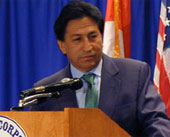Amidst great expectations, Alejandro Toledo became President of Peru in June 2001. His arrival in power put an end to 10 years of Alberto Fujimori’s authoritarian government and marked the beginning of a new democratic era. Yet a mere two years after Toledo assumed the presidency, his popularity has hit rock bottom. The latest polls reveal that only 10% of Peruvians approve of his administration. “The political situation has been very tense and the popularity of the president has nose-dived,” states Mario Vargas Llosa, the prestigious writer who was a Peruvian presidential candidate in 1990. How did Toledo’s power erode so quickly, and what is he doing to restore his authority?

Sign up to stay informed about our latest article releases.